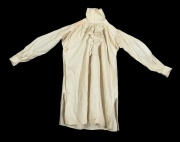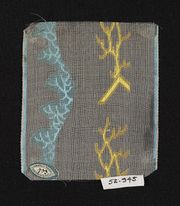Difference between revisions of "Plain weave"
| Line 3: | Line 3: | ||
[[File:Silk tabby MFA.jpg|thumb|Silk tabby fragment <br>MFA# 52.945]] | [[File:Silk tabby MFA.jpg|thumb|Silk tabby fragment <br>MFA# 52.945]] | ||
[[File:Wool valance MFA.jpg|thumb|Plain weave wool valance; MFA# 11.149]] | [[File:Wool valance MFA.jpg|thumb|Plain weave wool valance; MFA# 11.149]] | ||
| − | One of three fundamental fabric weaving patterns: plain, [[satin%20weave|satin]], and [[twill%20weave|twill]]. Plain weave fabrics are made by passing filling threads over then under each warp thread. The adjacent filling thread reverses the lacing pattern by going under then over each of the warp threads. Both the filling and warp threads are equal in thickness. Plain weave fabrics can the tightly or loosely woven. Examples of plain weave fabrics are: [[calico|calico]], [[cambric|cambric]], [[canvas|canvas]], [[cheesecloth|cheesecloth]], [[chiffon|chiffon]], [[chintz|chintz]], [[crepe|crepe]], [[georgette|georgette]], [[gingham|gingham]], [[homespun|homespun]], [[linen|linen]], [[muslin|muslin]], [[percale|percale]], [[organdy|organdy]], [[seersucker|seersucker]], and [[taffeta|taffeta]]. Some variations of plain weave fabrics use different size filling and warp threads. Examples of these are [[broadcloth|broadcloth]], [[grosgrain|grosgrain]], [[poplin|poplin]], [[faille|faille]], and [[bengaline|bengaline]]. | + | One of three fundamental fabric weaving patterns: plain, [[satin%20weave|satin]], and [[twill%20weave|twill]]. Plain weave fabrics are made by passing filling threads over then under each warp thread. The adjacent filling thread reverses the lacing pattern by going under then over each of the warp threads. Both the filling and warp threads are equal in thickness. Plain weave fabrics can the tightly or loosely woven. Examples of plain weave fabrics are: [[calico|calico]], [[cambric|cambric]], [[canvas|canvas]], [[cheesecloth|cheesecloth]], [[chiffon|chiffon]], [[chintz|chintz]], [[crepe|crepe]], [[georgette|georgette]], [[gingham|gingham]], [[homespun|homespun]], [[linen|linen]], [[muslin|muslin]], [[percale|percale]], [[organdy|organdy]], [[seersucker|seersucker]], [[tabby]] and [[taffeta|taffeta]]. Some variations of plain weave fabrics use different size filling and warp threads. Examples of these are [[broadcloth|broadcloth]], [[grosgrain|grosgrain]], [[poplin|poplin]], [[faille|faille]], and [[bengaline|bengaline]]. |
== Synonyms and Related Terms == | == Synonyms and Related Terms == | ||
Revision as of 11:07, 20 October 2020
Description
One of three fundamental fabric weaving patterns: plain, satin, and twill. Plain weave fabrics are made by passing filling threads over then under each warp thread. The adjacent filling thread reverses the lacing pattern by going under then over each of the warp threads. Both the filling and warp threads are equal in thickness. Plain weave fabrics can the tightly or loosely woven. Examples of plain weave fabrics are: Calico, Cambric, Canvas, Cheesecloth, Chiffon, Chintz, Crepe, Georgette, Gingham, Homespun, Linen, Muslin, Percale, Organdy, Seersucker, Tabby and Taffeta. Some variations of plain weave fabrics use different size filling and warp threads. Examples of these are Broadcloth, Grosgrain, Poplin, Faille, and Bengaline.
Synonyms and Related Terms
tabby weave; simple weave; ligamento de tafetán (Esp.)
Resources and Citations
- M. Joseph, Introductory Textile Science, Holt Reinhold & Winston, Fort Worth, 1986.
- Hoechst Celanese Corporation, Dictionary of Fiber & Textile Technology (older version called Man-made Fiber and Textile Dictionary, 1965), Hoechst Celanese Corporation, Charlotte NC, 1990
- Rosalie Rosso King, Textile Identification, Conservation, and Preservation, Noyes Publications, Park Ridge, NJ, 1985
- Fairchild's Dictionary of Textiles, Phyllis G.Tortora, Robert S. Merkel (eds.), Fairchild Publications, New York City, 7th edition, 1996
- Edward Reich, Carlton J. Siegler, Consumer Goods: How to Know and Use Them, American Book Company, New York City, 1937


